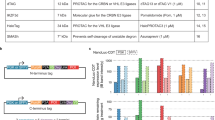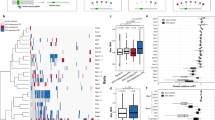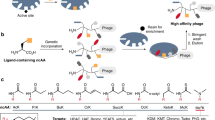Abstract
Based on the prevalence of modular protein domains, such as Src homology domain 3 and 2 (SH3 and SH2), among important signaling molecules, we have sought to identify new SH3 domain-containing proteins. However, modest sequence similarity among these domains restricts the use of DNA-based methods for this purpose. To circumvent this limitation, we have developed a functional screen that permits the rapid cloning of modular domains based on their ligand-binding activity. Using operationally defined SH3 ligands from combinatorial peptide libraries, we screened a series of mouse and human cDNA expression libraries. We found that 69 of the 74 clones isolated encode at least one SH3 domain. These clones encode 18 different SH3-containing proteins, 10 of which have not been described previously. The isolation of entire repertoires of modular domain-containing proteins will prove invaluable in genome analysis and in bringing new targets into drug discovery programs.
This is a preview of subscription content, access via your institution
Access options
Subscribe to this journal
Receive 12 print issues and online access
$209.00 per year
only $17.42 per issue
Buy this article
- Purchase on Springer Link
- Instant access to full article PDF
Prices may be subject to local taxes which are calculated during checkout
Similar content being viewed by others
References
Cohen, G.B., Ren, R. and Baltimore, D. 1995. Modular binding domains in signal transduction proteins. Cell 80: 237–248.
Pawson, T. 1995. Protein module and signalling networks. Nature 373: 573–560.
Cicchetti, P., Mayer, B.J., Thiel, G. and Baltimore, D. 1992. Identification of a protein that binds to the SH3 region of Abl and is similar to Bcr and GAP-rho. Science 257: 803–806.
Ren, R., Mayer, B., Cicchetti, P. and Baltimore, D. 1993. Identification of a ten-amino acid proline-rich SH3 binding site. Science 259: 1157–1161.
Chen, J.K., Lane, W.S., Brauer, A.W., Tanaka, A. and Schreiber, S.L. 1993. Biased combinatorial libraries: novel ligands for the SH3 domain of phosphatidylinositol 3-kinase. J. Am. Chem. 115: 12591–12592.
Cheadle, C. et al. 1994. Identification of a Src SH3 domain binding motif by screening a random phage display library. J. Biol. Chem. 269: 24034–24039.
Rickles, R.J. et al. 1994. Identification of Src, Fyn, Lyn, PI3K, and Abl SH3 domain ligands using phage display libraries. EMBO J. 13: 5598–5604.
Sparks, A.B., Quilliam, L.A., Thorn, J.M., Der, C.J. and Kay, B.K. 1994. Identification and characterization of Src SH3 ligands from phage-displayed random peptide libraries. J. Biol. Chem. 269: 23853–23856.
Yu, H., Chen, J.K., Feng, S., Dalgarno, D.C., Brauer, A.W. and Schreiber, S.L. 1994. Structural basis for the binding of proline-rich peptides to SH3 domains. Cell 76: 933–945.
Sparks, A., Rider, J., Hoffman, N., Fowlkes, D., Quilliam, L. and Kay, B. 1996. Distinct ligand preferences of SH3 domains from Src, Yes, Abl, cortactin, p53BP2, PLCγ, Crk, and Grb2. Proc. Natl. Acad. Sci. USA 93: 1540–1544.
Skolnik, E. et al. 1991. Cloning of PI3 kinase-associated p85 utilizing a novel method for expression/cloning of target proteins for receptor tyrosine kinases. Cell 65: 83–90.
Feng, S., Chen, J., Yu, H., Simmon, J. and Schreiber, S. 1994. Two binding orientations for peptides to the Src SH3 domain: development of a general model for SH3-ligand interactions. Science 266: 1241–1247.
Lim, W.A., Richards, F.M. and Fox, R. 1994. Structural determinants of peptide-binding orientation and of sequence specificity in SH3 domains. Nature 372: 375–379.
Iwabuchi, K., Bartel, P.L., Li, B., Marraccino, R. and Fields, S. 1994. Two cellular proteins that bind to wild-type but not mutant p53. Proc. Natl. Acad. Sci. USA 91: 6098–6102.
Tomasetto, C. et al. 1995. Identification of four novel human genes amplified and overexpressed in breast carcinoma and located to the q11 -q21.3 region of chromosome 17. Genomics 28: 367–376.
Wu, H. and Parsons, J.T. 1993. Cortactin, an 80/85-kilodalton pp60src substrate, is a filamentous actin-binding protein enriched in the cell cortex. J. Cell Biol. 120: 1417–1426.
Ishikawa, R. et al. 1994. Drebrin, a development-associated brain protein from rat embryo, causes the dissociation of tropomyosin from actin filaments. J. Biol. Chem. 269: 29928–29933.
David, C., Solimena, M. and DeCamilli, P. 1994. Autoimmunity in stiff-Man syndrome with breast cancer is targeted to the C-terminal region of human amphiphysin, a protein similar to the yeast proteins, Rvs167 and Rvs161. FEBS Lett. 351: 73–79.
Fukamachi, H. et al. 1994. Identification of a protein, SPY75, with repetitive helix-turn-helix motifs and an SH3 domain as a major substrate for protein tyrosine kinase(s) activated by Fc epsilon RI cross-linking. J. Immunol. 152: 642–652.
Knudsen, B.S., Feller, S.M. and Hanafusa, H. 1994. Four proline-rich sequences of the guanine-nucleotide exchange factor C3G bind with unique specificity to the first Src homology 3 domain of Crk. J. Biol. Chem. 269: 32781–32787.
Vagen-Descroiz, M. et al. 1991. Isolation and characterisation of porcine sorbin. Eur. J. Biochem. 201: 53–60.
Margolis, B., Skolnik, E.Y. and Schlessinger, J. 1995. Use of tyrosine-phosphorylated proteins to screen bacterial expression libraries of SH2 domains. Meth. Enzymol. 255: 360–369.
Kawakami, T., Kawakami, Y., Aaronson, S.A. and Robbins, K.C. 1988. Acquisition of transforming properties by FYN, a normal SRC-related human gene. Proc. Natl. Acad. Sci. USA 85: 3870–3874.
Yamanashi, Y. et al. 1987. The yes-related cellular gene lyn encodes a possible tyrosine kinase similar to p56lck. Mol. Cell. Biol. 7: 237–243.
Clark, S.G., Stern, M.J. and Horvitz, H.R. 1992. C. elegans cell-signalling gene sem-5 encodes a protein with SH2 and SH3 domains. Nature 356: 340–344.
Songyang, Z. et al. 1993. SH2 domains recognize specific phosphopeptide sequences. Cell 72: 767–778.
Songyang, Z., Margolis, B., Chaudhuri, M., Shoelson, S.E. and Cantley, L.C. 1995. The phosphotyrosine interaction domain of She recognizes tryosine-phosphorylated NPXY motif. J. Biol. Chem. 270: 14863–14866.
Author information
Authors and Affiliations
Rights and permissions
About this article
Cite this article
Sparks, A., Hoffman, N., McConnell, S. et al. Cloning of ligand targets: Systematic isolation of SH3 domain-containing proteins. Nat Biotechnol 14, 741–744 (1996). https://doi.org/10.1038/nbt0696-741
Received:
Accepted:
Issue Date:
DOI: https://doi.org/10.1038/nbt0696-741
This article is cited by
-
BIN1 favors the spreading of Tau via extracellular vesicles
Scientific Reports (2019)
-
Mechanisms of PINK1, ubiquitin and Parkin interactions in mitochondrial quality control and beyond
Cellular and Molecular Life Sciences (2019)
-
Osteoclast stimulation factor 1 (Ostf1) KNOCKOUT increases trabecular bone mass in mice
Mammalian Genome (2017)
-
The Mll-Een knockin fusion gene enhances proliferation of myeloid progenitors derived from mouse embryonic stem cells and causes myeloid leukaemia in chimeric mice
Leukemia (2006)
-
SH3P7/mAbp1 deficiency leads to tissue and behavioral abnormalities and impaired vesicle transport
The EMBO Journal (2006)



